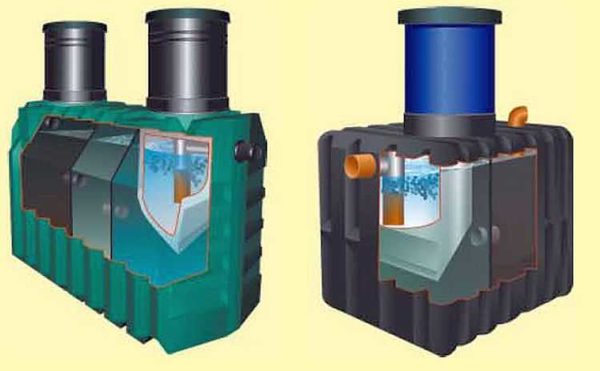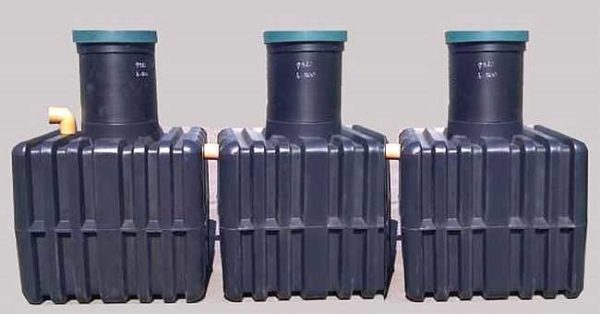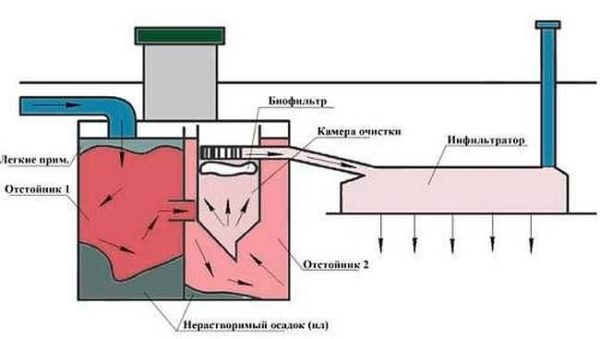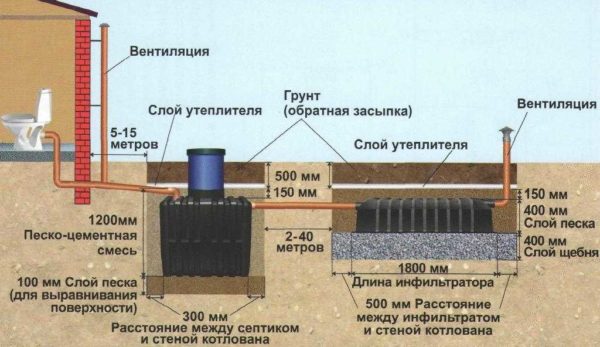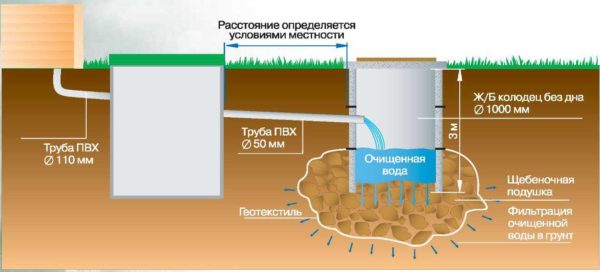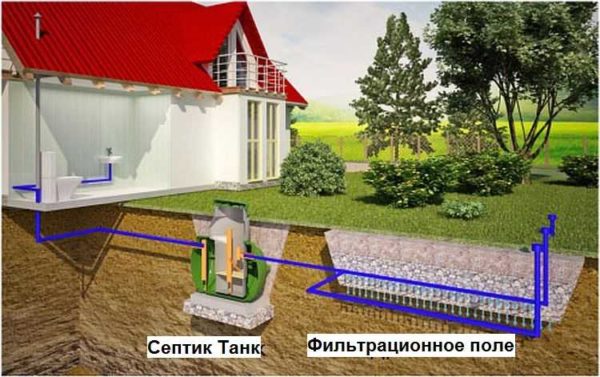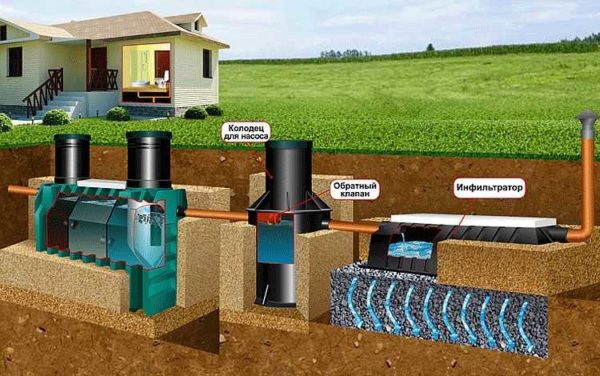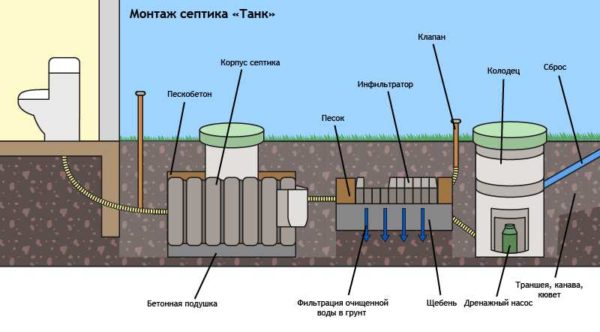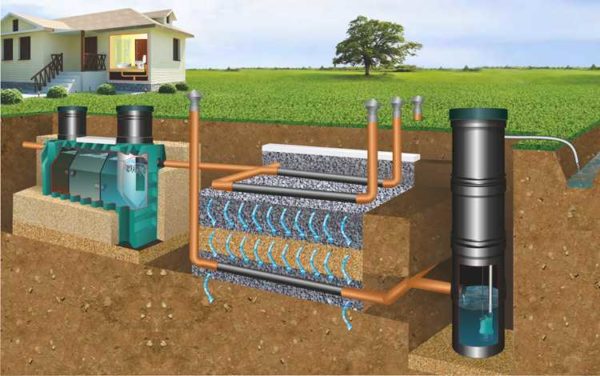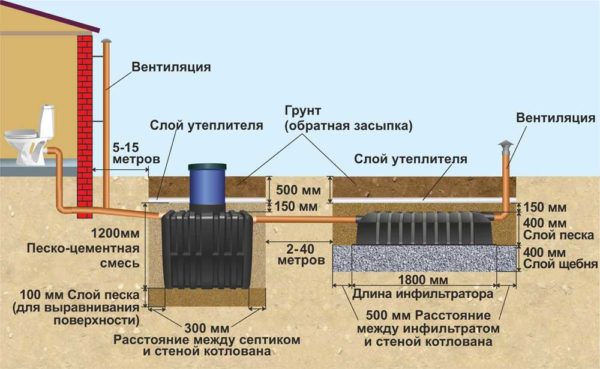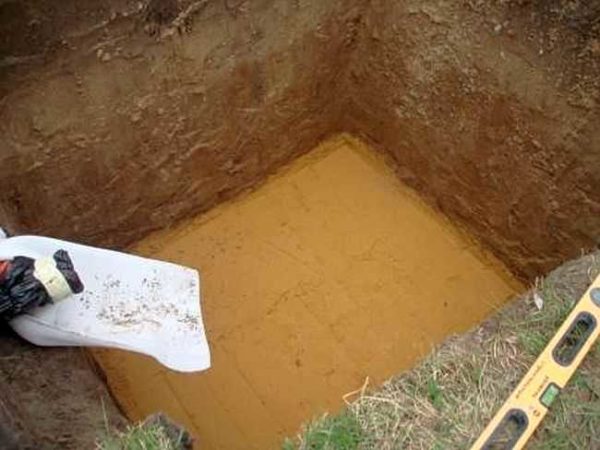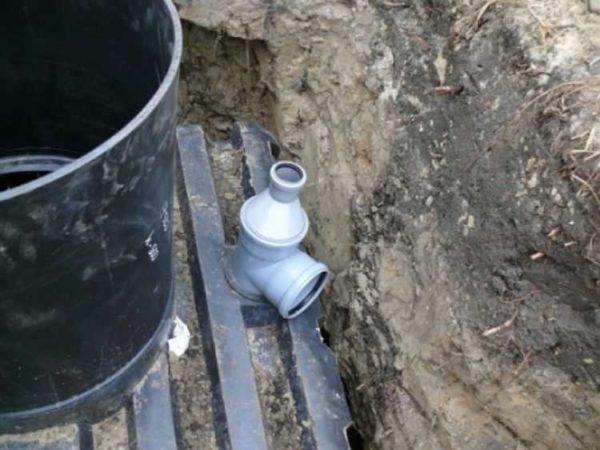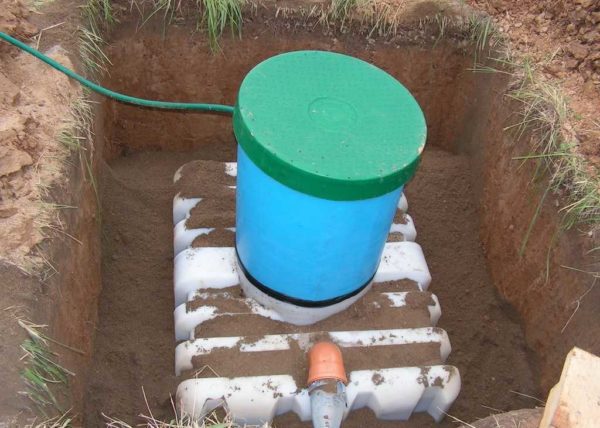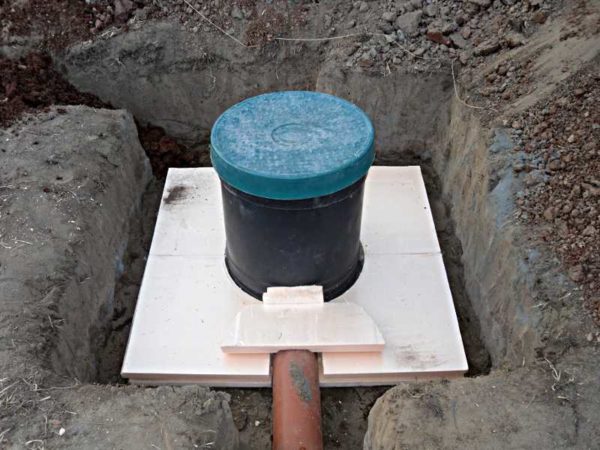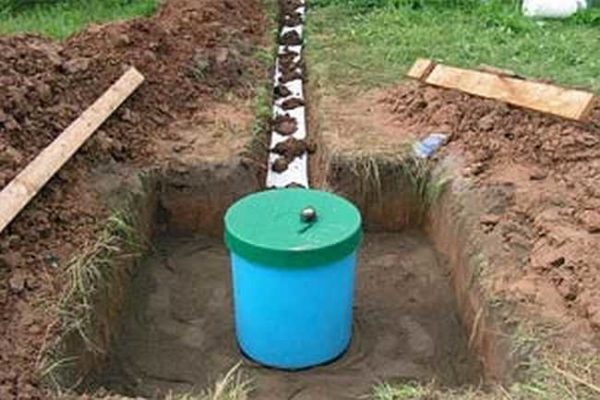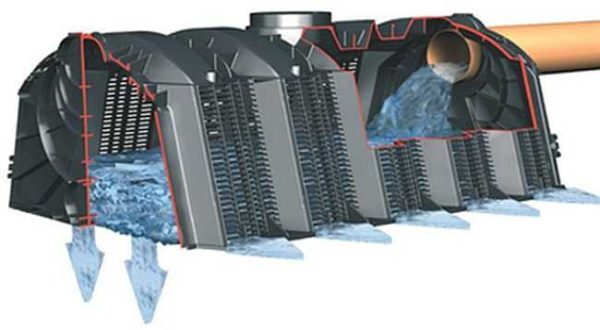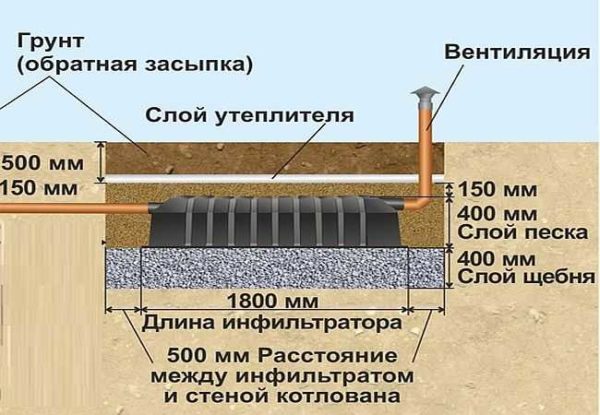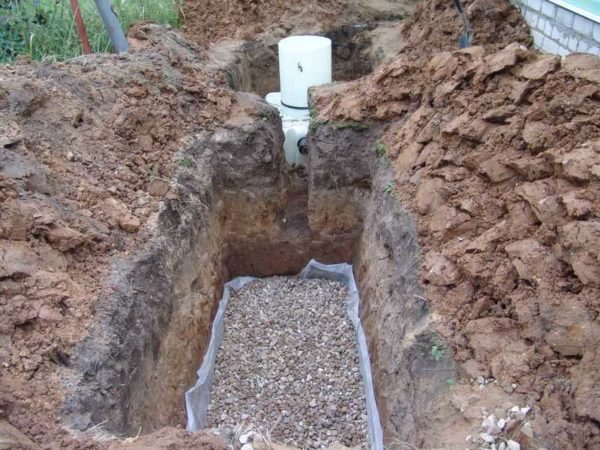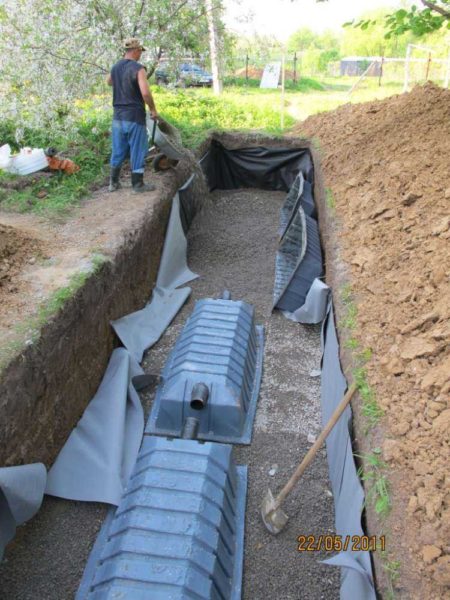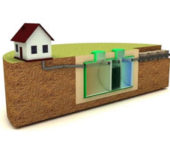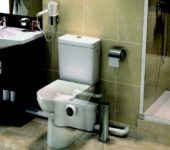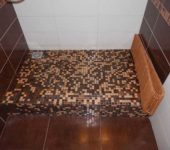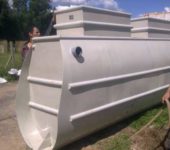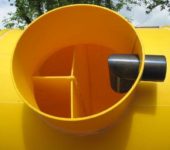Septic tank: principle of operation, installation, maintenance
Individual sewerage in the house or in the country is the dream of many. Everyone is tired of using the outdoor toilet for a long time. Usually the limiting factor is the lack of the required amount. In this case, you can make a wastewater treatment system using a septic tank. It has a relatively low price, its service life is about 50 years.
The content of the article
Design and working principle
Septic Tank looks like a large plastic cube with a ribbed surface and a neck (or two) sticking out above the surface. Inside, it is divided into three compartments, in which waste water is purified.
The body of this septic tank is one-piece cast, has no seams. There are seams only at the neck connection. This seam is welded, practically monolithic - 96%.
Although the case is plastic, it is definitely not fragile - a decent wall thickness (10 mm) and additional even thicker ribs (17 mm) add strength. Interestingly, when installing a septic tank, the Tank does not require a plate and anchoring. At the same time, even with a high level of groundwater, this installation does not float, but this is subject to the installation requirements (more about them below).
Another design feature is the modular structure. That is, if you already have such an installation, and find that its volume is not enough for you, just install another section next to it, connect it to the already working one.
Principle of operation
Septic Tank works in the same way as many other similar installations. The procedure for purifying wastewater is as follows:
- Water draining from the house enters the receiving compartment. It has the largest volume. While it fills up, the waste decomposes and ferments. The process is carried out with the help of bacteria that are contained in the waste itself, and good conditions are simply created in the tank for their life. During the cleaning process, solid sediments fall to the bottom, where they are gradually pressed. Lighter greasy dirt particles rise upward, forming a film on the surface. More or less pure water located in the middle part (purification at this stage is about 40%) enters the second chamber through the overflow hole.
- In the second compartment, the process continues. The result is an additional 15-20% cleansing.
- The third chamber has a biofilter at the top. It carries out additional wastewater treatment up to 75%. Through the overflow hole, water is removed from the septic tank for further post-treatment (into the filter column, into the filtration fields - depending on the type of soil and the level of groundwater).
Not a bad way out
As you can see, there are no difficulties. With proper installation and operation, the septic tank tank works flawlessly - it does not depend on electricity, so that it is not afraid of frequent power outages in rural areas. Also, the installation tolerates an uneven schedule of use, which is typical for summer cottages. In this case, the flow of wastewater on weekdays is usually minimal or absent, and reaches a maximum on weekends. This work schedule does not affect the cleaning result in any way.
The only thing that is necessary for summer cottages is conservation for the winter, if accommodation is not planned.To do this, you need to pump out the sludge, fill all the containers with water by 2/3, insulate the top well (pour foliage, tops, etc.). In this form, you can leave for the winter.
Features of operation
Like any septic tank, the Tank reacts poorly to a large amount of active chemicals - a one-time intake of a large amount of water with bleach or a chlorine-containing preparation kills bacteria. Accordingly, the quality of cleaning deteriorates, an odor may appear (during normal operation, it is absent). The way out is to wait for the bacteria to multiply or add them out forcibly (bacteria for septic tanks are commercially available).
| Name | Dimensions (L * W * H) | How much can clean | Volume | Weight | Septic tank price Tank | Installation price |
|---|---|---|---|---|---|---|
| Septic Tank - 1 (no more than 3 people). | 1200 * 1000 * 1700mm | 600 sheets / day | 1200 liters | 85 kg | 330-530 $ | from 250 $ |
| Septic Tank - 2 (for 3-4 people). | 1800 * 1200 * 1700mm | 800 sheets / day | 2000 liters | 130 kg | 460-760 $ | from 350 $ |
| Septic Tank - 2.5 (for 4-5 people) | 2030 * 1200 * 1850mm | 1000 sheets / day | 2500 liters | 140 kg | 540-880 $ | from 410 $ |
| Septic Tank - 3 (for 5-6 persons) | 2200 * 1200 * 2000mm | 1200 sheets / day | 3000 liters | 150 Kg | 630-1060 $ | from 430 $ |
| Septic Tank - 4 (for 7-9 persons) | 3800 * 1000 * 1700mm | 600 sheets / day | 1800 liters | 225 kg | 890-1375 $ | from 570 $ |
| Infiltrator 400 | 1800 * 800 * 400mm | 400 liters | 15 kg | 70 $ | from 150 $ | |
| Cover D 510 | 32 $ | |||||
| Extension neck D 500 | height 500 mm | 45 $ | ||||
| Well for pump D 500 | height 600 mm | 120 $ | ||||
| Well for pump D 500 | height 1100 mm | 170 $ | ||||
| Well for pump D 500 | height 1600 mm | 215 $ | ||||
| Well for pump D 500 | height 2100 mm | 260$ |
Another of the features that must be taken into account is not to flush waste that is not decomposed by bacteria into the sewer. As a rule, this is waste that appears during repairs. Not only can they clog the drain and you have to clean it, so these particles also significantly increase the amount of sludge, and you will have to clean the septic tank more often.
Methods for organizing additional treatment
At the outlet of the septic tank Tank, the drains are 75-80% purified. As you can imagine, you won't be able to use them without additional treatment. There are several options here, and in many respects they depend on the type of soil (their ability to drain water) and the level of groundwater.
Normal absorbency and medium to low GWL
There is a standard way of water drainage, developed by the same company - the installation of an infiltrator. An infiltrator is a container of a special shape, at the bottom of which there are numerous holes through which conditionally pure water flows down. This device is installed on a large crushed stone pillow - its minimum thickness is 40 cm (this is with the normal ability of the soil to drain water, if the soil is clay or loam, the layer is increased). Residues of pollution remain on the rubble, and clean water goes into the ground.
The second option for post-treatment of wastewater after the septic tank Tank is a filtration column. These are several concrete rings (2-4 pcs.) Of meter diameter, dug into the ground near the wastewater treatment plant. First, a foundation pit is dug under this column, a crushed stone pillow is poured onto the bottom, then rings are installed, their joints are sealed, after which the gap between the walls of the well and the foundation pit is filled up. The bottom ring can have perforated walls. Through these holes or through the missing bottom, water is absorbed into the ground, where it is completely purified.
Which is better - a column or an infiltrator
If we compare these two systems, then the installation of infiltrates is more environmentally friendly, and in practical terms it is more convenient. The fact is that after some time the rubble will become silted up with the remnants of pollution, the water will stop leaving. To restore the post-treatment efficiency, the crushed stone must be replaced. As is clear from the design, it is easier to do this if infiltrators are installed in a pair to the septic tank. Their second plus is a large area from which water leaves. One infiltrator has an area of contact with the ground - 21 frames, at a well - only a circle with a diameter of 1 meter, if the rings are ordinary, or about 4 squares, if the walls of the last ring are perforated.
Filtration field
The third option is the device of the filtration field.This is when a fertile layer of earth is removed in a certain area, part of the soil is replaced with sand and rubble (at least 30 cm each), plastic pipes are laid on top of this pillow, in the walls of which drainage holes are drilled. The laid pipes are covered with crushed stone, on top - soil.
Lawn grass is planted on this site or a flower garden is made in this place. You cannot use this area for a garden or vegetable garden. The disadvantages of this method of post-treatment of effluents are that a large area is required, a large volume of sand and gravel, which will have to be changed after a while (it will also silt up).
The choice of the best septic tank for home and summer cottages is described here.
Periodic rise in groundwater level with normal soils
Many houses are located in areas where groundwater rises periodically - during snow melting or lingering autumn rains. At the same time, the soil on the site normally removes water (sand, sandy loam, etc.), under normal conditions the water leaves quickly and only periodically its amount is so large that it can already stand half a meter below the ground level.
In this case, a storage well is placed between the septic tank and the post-treatment plant, in which almost purified water can be kept for some time until the groundwater is gone. Then the water will be able to "dissolve" on its own. In this case, the methods of post-treatment of effluents are similar to those described above.
High groundwater table
In fact, the scheme is the same - with an intermediate well between the septic tank Tank and post-treatment devices, but with a tangible difference:
- A check valve is installed on the pipe between the well and the septic tank. It is needed so that when the well overflows, the water does not go in the opposite direction - into the septic tank.
- It is imperative to use a pump to pump out wastewater if there is a threat of overfilling the system. They can be taken out to the same filtration plants.
- There is only one way of wastewater treatment - bulk filtration fields. Crushed stone is poured above the ground level, forming an area for wastewater treatment. Purified water gradually goes into the ground. These margins can be made with infiltrators or by using plastic sewer pipes with holes.
What else can be said about this case - the filtration fields have a large area. The entire volume of water must somehow go away. If there is a gutter nearby, after post-treatment, water can be directed there.
In general, the best solution for high groundwater levels is an aeration unit such as Topas, eg.
Poorly water-conducting soils
The most difficult case. Here, there is essentially one option - to make a filtering platform, and from it to remove the treated water into the gutter. Difficulty in the device of the filtering ditch - a large volume of crushed stone is required, as well as a system for collecting purified water.
The choice of a septic tank for the home is described here.
Advantages and disadvantages
The main advantage of the septic tank Tank is its energy independence, which is undoubtedly a plus in rural areas or in the country. The second pleasant point is the relatively low prices for installations. When compared with the cost of concrete rings for a homemade septic tank, it turns out not so cheap, but if you take into account the difference in delivery, installation speed, the difference does not seem so significant. Another plus compared to septic tanks made of concrete rings - the tightness of the hull, as well as the fact that, if properly installed, the Tank is not afraid of heaving or slight movements of the soil.
The disadvantages are common to all septic tanks. This is a relatively low degree of wastewater treatment - about 75%, and the need to organize additional treatment, which often doubles the cost of the entire system.
Step-by-step installation of a septic tank Tank
Installation of a septic tank The tank cannot be called difficult.The main thing is to dig a pit for a septic tank and post-treatment devices, as well as trenches for pipes that connect all this and the house into one system.
The depth of the septic tank installation The tank is determined by the depth of freezing. If it is not more than 1.50-1.70 cm, the septic tank is taken as standard. If the ground freezes by 2 meters or more, an additional neck is used, respectively, the installation depth increases.
The pit is dug so deep that only the lid + 3-5 cm on the sand bed remains above the ground to level the bottom. The dimensions of the pit should be 25 cm or more larger than the dimensions of the septic tank.
Septic tank installation Tank with photo
Further - step by step:
Preparation and
Digging a pit. This can be done manually or using a technique. We level the bottom, fill the sand with a layer of 3-5 cm, compact, level it.
- We lower the body. It is convenient to do this on ropes, passing them between the ribs.
- We check whether the septic tank has become even (a building level laid on the neck caps).
We connect the drain pipe from the house to the inlet pipe, which is located on the upper surface of the case. We also lay the pipe to post-treatment plants or to an intermediate well (depending on the chosen scheme). It is better to use polyethylene pipes for outdoor work (red). They can withstand negative temperatures, and normally carry loads.
Backfill
So that there are no problems with the septic tank, and after the winter it does not appear on the surface, it must be properly "anchored". For this, water is poured into the installed housing. It expands the walls to the working level. Gradually, soil is poured, rammed.
- When the level in the tank rises by about 20 cm, we begin to fill up the gap between the walls of the pit and the body of the septic tank. For backfilling, we use a sand-cement mixture: for 1 part of cement we take 5 parts of sand. It is necessary to fall asleep around the perimeter, manually, without using equipment. Having covered 20 cm, the layer is compacted with a manual rammer, taking care not to damage the body. During backfill, the water level in the septic tank should be 20-30 cm above the sand layer. This guarantees the correct position of the walls during operation.
- Having filled up the walls to the upper part of the body, add about 15 cm of the mixture, it is leveled and compacted.
- Lay a layer of insulation. The best option is extruded polystyrene foam (EPS), you can still use isofol. The use of foam is undesirable - it can flatten from soil loads and stop working. It is absolutely impossible to use mineral wool - it is hygroscopic and after a while it will simply crumble into dust. The layer of insulation depends on the region and the type of material used. For example, EPS for Central Russia requires 5 cm, for the northern regions - 10 cm.
- On top of the insulation we fill in the "native" soil. Backfill height - flush with the ground.
It's all. The septic tank is installed. There are a few more points regarding the creation of a sewer system. It makes sense to insulate the sewer pipe that comes from the house. In regions with not very cold winters, it is enough to lay the EPSP on top (it should cover the pipe and protrude 7-10 cm along the edges). It can be simply covered with soil.
In the northern regions, only insulation on the pipe may not be enough. In addition to this, the pipes are heated with heating cables for water and sewer pipes. In order for the heating efficiency to be higher, it is not laid outside, but inside the pipe. Only the casing must be resistant to aggressive media.
Infiltrator installation
One of the components of an individual sewerage system using a septic tank is an infiltrator. This is a device for post-treatment of effluent leaving a septic tank. It is a plastic container made in the form of a trapezoid, in the walls and bottom of which there are many slot-type holes.
Relatively small in size - 1800 * 800 * 400 mm, it holds up to 400 liters of liquid. It is laid on a crushed stone pillow with a height of 40 cm. Such a height of a crushed stone layer is necessary on soils with a normal ability to drain water, on flattened soils it can be 70 cm or more.
What to do
The number of infiltrators required depends on the size of the salvo discharge, as well as on the characteristics of the soil. With the same power of the installation, on sandy, well-draining soils, less additional cleaning elements are required than on soils with an average or poor drainage capacity.
The procedure for installing an infiltrator for final wastewater treatment is as follows:
- Digging a pit, which is 500 mm larger than the infiltrator.
- We line the bottom and walls geotextile... It is needed so that the crushed stone does not mix with the soil.
- We fill in and level the layer of rubble.
- We put the body of the infiltrator.
- We connect it to the outlet of the septic tank.
- We install the ventilation pipe.
- We fill up with sand so that it covers the body from above by 15 cm.
- We lay a layer of insulation (it can be the same as on the body of the septic tank Tank).
- We fall asleep with soil.
When installing the infiltrator, it is not necessary to use a mixture of sand and cement, since the body lies on a crushed stone pad, which successfully compensates for all movements.

